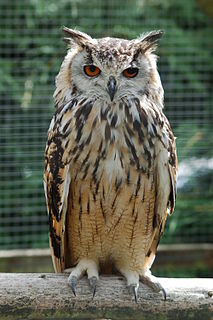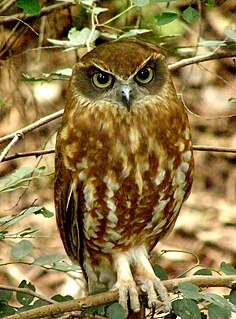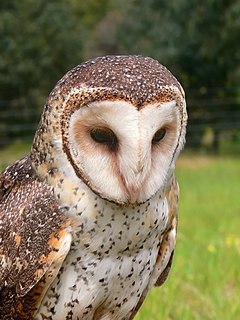
Owls are birds from the order Strigiformes, which includes about 200 species of mostly solitary and nocturnal birds of prey typified by an upright stance, a large, broad head, binocular vision, binaural hearing, sharp talons, and feathers adapted for silent flight. Exceptions include the diurnal northern hawk-owl and the gregarious burrowing owl.

The morepork, also called the ruru or Tasmanian spotted owl, is a small brown owl found throughout New Zealand and Tasmania. Described by Johann Friedrich Gmelin in 1788, it was for many years considered to be the same species as the Australian boobook of mainland Australia until 1999. Its name is derived from its two-tone call. Four subspecies of the morepork are recognized, one of which is extinct and another that exists only as a hybrid population. The bird has almost 20 alternative common names, including mopoke and boobook—many of these names are onomatopoeic, as they emulate the bird's distinctive two-pitched call.

The American horned owls and the Old World eagle-owls make up the genus Bubo, at least as traditionally described. The genus name Bubo is Latin for the Eurasian eagle-owl.

The little owl is a bird that inhabits much of the temperate and warmer parts of Europe, Asia east to Korea, and north Africa. It was introduced into Britain at the end of the nineteenth century and into the South Island of New Zealand in the early twentieth century.

The barn owl is the most widely distributed species of owl and one of the most widespread of all birds. It is also referred to as the common barn owl, to distinguish it from other species in its family, Tytonidae, which forms one of the two main lineages of living owls, the other being the typical owls (Strigidae). The barn owl is found almost everywhere in the world except polar and desert regions, in Asia north of the Himalaya, most of Indonesia, and some Pacific islands.

The barred owl, also known as northern barred owl or hoot owl, is a true owl native to eastern North America. Adults are large, and are brown to grey with barring on the chest. Barred owls have expanded their range to the west coast of North America, where they are considered invasive. Mature forests are their preferred habitat, but they are also found in open woodland areas. Their diet consists mainly of small mammals, but they are also known to prey upon other small animals such as birds, reptiles, and amphibians.

The brown fish owl is a fish owl species in the family known as typical owls, Strigidae. It is native from Turkey to South and Southeast Asia. Due its wide distribution it is listed as Least Concern on the IUCN Red List. It inhabits forests and wooded wetlands. Of the four living species of fish owl, it is the most widely distributed, most common and best-studied. It occupies a range of over 7,000 km (4,300 mi).

The brown hawk-owl, also known as the brown boobook, is an owl which is a resident breeder in south Asia from India, Sri Lanka, Bangladesh and Nepal east to western Indonesia and south China.

The laughing owl, also known as whēkau or the white-faced owl, was an endemic owl of New Zealand. Plentiful when European settlers arrived in New Zealand, its scientific description was published in 1845, but it was largely or completely extinct by 1914. The species belonged to the monotypic genus Sceloglaux, although recent genetic studies indicate that it belongs with the boobook owls in the genus Ninox.

The Australian boobook is a species of owl native to mainland Australia, southern New Guinea, the island of Timor, and the Sunda Islands. Described by John Latham in 1801, it was generally considered to be the same species as the morepork of New Zealand until 1999. Its name is derived from its two-tone boo-book call. Eight subspecies of the Australian boobook are recognized, with three further subspecies being reclassified as separate species in 2019 due to their distinctive calls and genetics.

Ninox is a genus of true owls comprising about 30 species found in Asia and Australasia. Many species are known as hawk owls or boobooks, but the northern hawk-owl Surnia ulula is not a member of this genus. Molecular analysis indicates the genus is an early offshoot from the ancestors of the rest of the true owls, and are maybe best-classified in a subfamily Ninoxinae with the genera Sceloglaux and Uroglaux. The genus was introduced by the English naturalist Brian Houghton Hodgson in 1837.

The Australian masked owl is a barn owl of Southern New Guinea and the non-desert areas of Australia.
The New Zealand owlet-nightjar was a large species of owlet-nightjar formerly endemic to the islands of New Zealand. Fossil remains indicate the species was once widespread across both the North Island and the South Island. Despite a small number of reports of small owls being found in the 19th century that may have been New Zealand owlet-nightjars, the species is thought to have become extinct around 1200 AD.

The pipipi, also known as brown creeper, New Zealand creeper, or New Zealand titmouse, is a small passerine bird endemic to the South Island of New Zealand. They are specialist insectivores, gleaning insects from branches and leaves. They have strong legs and toes for hanging upside down while feeding.

The eastern grass owl, or Australian grass owl is a species of owl in the family Tytonidae. They feed predominantly on small rodents.

The Norfolk boobook, also known as the Norfolk Island boobook, Norfolk Island owl or Norfolk Island morepork, was a bird in the true owl family endemic to Norfolk Island, an Australian territory in the Tasman Sea between Australia and New Zealand. It is an extinct subspecies of the morepork. However, although the taxon is extinct, its genes live on in the descendants of the hybrid offspring of the last female bird, which was sighted for the last time in 1996.

"Good Time" is a song by American electronica project Owl City and Canadian singer Carly Rae Jepsen. It was released as the lead single from Owl City's album The Midsummer Station and was used as the second single from Jepsen's second studio album, Kiss. "Good Time" was written by Matt Thiessen, Brian Lee, and Adam Young of Owl City. The song received generally positive reviews from music critics, with critics describing it as a "summer anthem".















